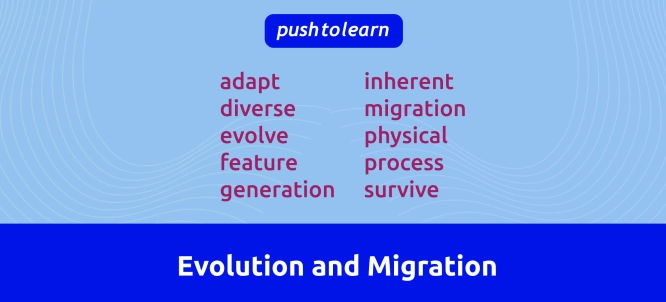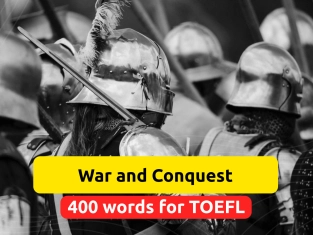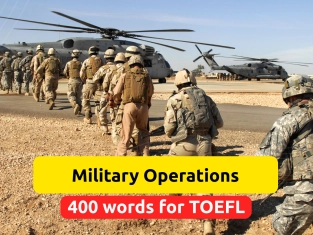by PushtoLearn
Evolution and Migration
Table of Contents
Evolution and Migration Flashcards - Vocabulary Practice for TOEFL
These exercises focus on Evolution and Migration Vocabulary
Vocabulary List for Evolution and Migration
-
adapt (v.): to adjust or change behavior, structure, or habits so as to become more suitable for a new environment or situation.
Example: Over many years, polar bears adapt to colder climates by developing thicker fur. -
diverse (adj.): containing many different types or forms; varied.
Example: A tropical rainforest is home to diverse species of plants and animals. -
evolve (v.): to develop gradually over a long period, often into a more complex or better form; in biology, to develop new traits through genetic changes across generations.
Example: Birds are believed to have evolved from small, feathered dinosaurs. -
feature (n.): a distinctive characteristic or quality that something possesses.
Example: One key feature of human beings is the ability to use language. -
generation (n.): a group of living beings constituting a single step in the line of descent; people born and living at about the same time.
Example: Within one generation, many species can undergo noticeable changes. -
inherent (adj.): existing as a natural and permanent quality of something; built-in or inseparable from something’s nature.
Example: The ability to swim is not inherent in humans; we must learn it. -
migration (n.): the movement of a group of people or animals from one place to another, often seasonally or due to changes in environment or resources.
Example: The migration of wildebeests across East Africa happens every year. -
physical (adj.): relating to the body or material things, rather than the mind or spirit.
Example: The physical differences between species often reflect their environment. -
process (n.): a series of steps or actions that lead to a particular result or change.
Example: The process of evolution involves gradual genetic changes over many generations. -
survive (v.): to continue living, especially in spite of danger or hardship.
Example: Only those plants that can store water in their leaves survive the long desert dry season.

Summary Table
|
Word |
Definition |
Example |
|
Adapt |
To change to fit a new environment |
"Polar bears adapted to cold climates." |
|
Diverse |
Having variety |
"A rainforest is home to diverse species." |
|
Evolve |
To develop gradually over time |
"Birds evolved from dinosaur ancestors." |
|
Feature |
A distinctive characteristic |
"A camel’s hump is a key feature." |
|
Generation |
One stage in a species’ lineage |
"Beaks changed over many generations." |
|
Inherent |
Naturally existing as a fundamental quality |
"Inherent traits are passed through DNA." |
|
Migration |
Movement from one place to another |
"Wildebeest migrate annually." |
|
Physical |
Relating to the body or material world |
"Physical traits help survival." |
|
Process |
A series of steps towards a result |
"Evolution is a gradual process." |
|
Survive |
To continue living despite challenges |
"Only the fittest survive harsh winters." |
Examples in Context
-
Adapt: "As temperatures changed, some species had to adapt their diets and hunting strategies."
-
Diverse: "The Amazon rainforest is incredibly diverse, providing habitats for millions of species."
-
Evolve: "Marine mammals evolved from ancestors that once lived on land, eventually developing flippers."
-
Feature: "One notable feature of hummingbirds is their ability to hover while feeding on nectar."
-
Generation: "Over many generations, a species might develop entirely new color patterns."
-
Inherent: "The ability to breathe underwater isn’t inherent in humans; we must surface for air."
-
Migration: "The migration of monarch butterflies covers thousands of miles each year."
-
Physical: "The harsh desert environment influences the physical adaptations of many reptiles."
-
Process: "Evolution is a slow process, often taking thousands of years to produce noticeable changes."
-
Survive: "Only those organisms that can tolerate salty conditions survive in coastal areas."
FAQ About the Evolution and Migration Vocabulary Module
How can I remember these words related to evolution and migration?
Use associations. For example, link “adapt” with a chameleon changing color. Visualize a map for “migration” as animals move from one region to another. Repeatedly review the words in context—reading articles, watching documentaries, or listening to lectures about evolution and animal movements.
What is the difference between “adapt” and “evolve”?
“Adapt” usually refers to individual organisms or short-term changes, like an animal adjusting to a new environment. “Evolve” refers to long-term genetic changes over many generations, shaping entire species.
Can “diverse” apply only to species?
No. “Diverse” can apply to any set of different types or forms. A classroom can be diverse if students come from various cultural backgrounds; a library can be diverse if it holds many kinds of books.
Is “inherent” the same as “innate”?
Both “inherent” and “innate” mean something that is naturally part of something else. “Inherent” often emphasizes that the quality is inseparable from the object’s nature. “Innate” usually suggests a quality or ability that an organism is born with.
How do “physical” traits differ from “behavioral” traits?
Physical traits relate to the body’s structure (like fur, feathers, or beak shape). Behavioral traits refer to actions or responses, like migrating each season or building a specific type of nest. Both can be shaped by evolution, but physical traits are more about body form, while behavioral traits are about what an organism does.

